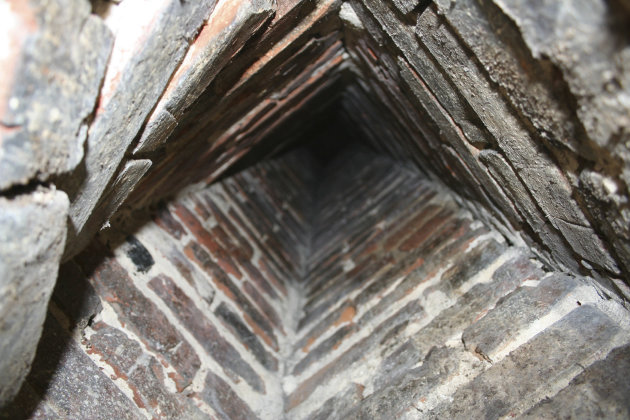"At least we know where he is now," Schexnider, 48, said, tears welling in his eyes ahead of his brother's weekend funeral and burial. "At least he's home."
Nearly three decades after he disappeared, much mystery lingers about the case of Joseph Schexnider and involving a small town bank in the southern Louisiana city of Abbeville. Police say Schexnider became trapped and apparently died in the bank's chimney in 1984. But beyond that, they know little more.
"Everybody has an opinion," said Lt. David Hardy, chief of investigations for the Abbeville Police Department. "But no one has evidence to say one way or another."
If Joseph Schexnider did cry out for help, no one heard his pleas. The stench of death was never detected.
The decades rolled on until last May when a construction worker helping turn the bank's vacant second floor into offices tugged some fabric out of the chimney and was showered with old clothes and human bones.
Described as sweet-natured and relaxed by the few who remember him, Joseph Schexnider was 22 when his family last saw him in January 1984. He had no criminal record, but was wanted for possessing a stolen car.
A lanky, rambling man, Schexnider was prone to wandering at an early age.
In the years after they last saw them, his family, his mother, and two brothers and a sister, had not reported him missing — and no one searched for him.
"My mother worried about him, but I just said, 'Mom, that's just Joseph being Joseph,'" Robert Schexnider said. "He was always taking off for somewhere."
Joseph first ran off around the age of 9 or 10, Robert recalled, adding his brother had dropped out of high school in the ninth grade.
He worked now and then at this and that, quitting jobs when he became tired and moving on. He was briefly in the Louisiana National Guard, leaving with a medical discharge. One of the few pictures of him shows him in uniform, his dark eyes looking off into the distance.
"He was always going off somewhere," Robert Schexnider said. "He told me he'd seen every state in the country."
Schexnider followed carnivals and once traveled with a circus. He told his brother he hawked cotton candy and peanuts with the shows, traveling with the circus to New York where he was stranded when it left to go overseas.
"He didn't have enough money to get home, so the church helped him out," recalled Francis Plaisance, a city councilman and the pastor of the church the Schexniders attended. "I remember him as being a nice kid."
Plaisance also remembers Joseph as a somewhat simple person. When the church sent a plane ticket to New York for him to come home, Schexnider was unable to navigate the airport.
"We ended up having a pastor up there walking him through it and put him on the plane," Plaisance said.
Jason Hebert, now a detective with Abbeville Police, went to elementary school with Joseph Schexnider. He described him as quiet kid, on the fringe of a group of young boys that made mischief in the town.
"He was just another kid," Hebert said. "Nothing really stood out about him."
With the remains found in the chimney were a yellow long-sleeve shirt, a pair of jeans, blue tennis shoes, and jockey shorts with Schexnider's name printed in the waistband. There also was a magazine and gloves.
He had a wallet with a copy of his birth certificate, a Social Security card and a few pictures.
"There was no sign of foul play," Hardy said. But, he said, there is no way to determine the cause of death.
A DNA test confirmed his identity.
From the way the skeleton was recovered, Hardy said it appeared Schexnider went into the 14-inch-by-14-inch chimney feet first. Because the chimney narrowed sharply at the bottom, he then was apparently unable to maneuver his way back out.
There was no way out at the bottom of the chute, which ended in a 3-inch opening to a narrow fireplace on the second floor of the bank building.
"He was stuck with nowhere to go," Hardy said. If he had called for help — Hardy points out — he would have been 20 feet above the street, and encased in bricks.
"His voice would have been carried up and away from the street," Hardy added.
None of the people working on the floor below reported any strange sounds. No one ever went into the seldom-used second floor and reported any strange smells.
Abbeville is home to 12,000 people. Its picturesque downtown is a collection of late 19th-century one- and two-story buildings that have been carefully restored. The flat rooftops are well known to the town children. The two-story brick Abbeville Bank stands on a corner, its roof offering a view across the courthouse and beyond.
Access to the one- and two-story roofs was always an easy climb, Hebert said. He scampered on them as a kid; now as a police officer, he's chased children off the rooftops.
"We played up there a lot," Hebert said. "But I don't remember anyone ever going around the chimneys."
The chimneys on the downtown roofs were capped in 1987, but Schexnider went unnoticed.
His brother won't guess why Joseph went into the chimney, but acknowledged in his final days in town that Joseph had gotten in "with a bad crowd." He was carrying no burglary tools when found or anything to carry away money if he had planned to rob the bank.
Plaisance said he could see it as a misconceived burglary plan on Schexnider's part, however.
"He was the kind of guy who would do things without really thinking them through," Plaisance said.
After so many decades and so few clues, Abbeville Police have declared the case closed.


